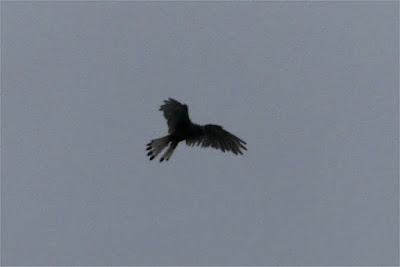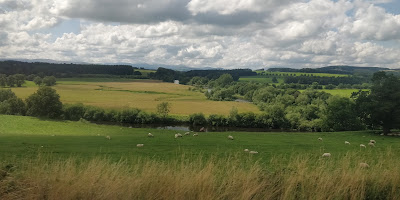 |
| Juvenile long-tailed tit, Chat Moss |
The back garden has taken on a primary school feel about it, someplace the parents drop the youngster off while they're busy elsewhere. A gang of just over half a dozen juvenile spadgers spend all day in the rambling rose before being gathered up by the duty cock sparrow of the day at tea time. The wren, like the blackbird, has gone quiet. They've both been productive: a juvenile blackbird is a fixture at the bird bath under the cherry tree and a juvenile wren keeps popping up out of the ferns under the dog rose. On the other hand I think the juvenile robin's been sent packing, the cock robin spends a lot of the day parading about the fences and jumping up and down on next door's washing line. The blue tits and great tits have pretty much finished their post-breeding moult and are making up for lost time by making inroads on the sunflower seeds.
The morning was busier than it should have been and I had things to do at lunchtime so it was early afternoon when I headed for the Trafford Centre and got the 100 to Cutnook Lane for a walk around Chat Moss in cloudy, clammy weather.
 |
| Cutnook Lane by the motorway |
There was a lot going on in the trees by the lane just over the motorway bridge. Unfortunately nearly all of it was soft contact calls overlaid by traffic noise. I managed to pick out at least one great tit and eventually the wren made it easy by bursting into song.
 |
| Treecreeper |
The walk down Cutnook Lane was quiet, punctuated by the occasional squeak from a chiffchaff or great tit and the noise of coots on the fishery.. Crossing Twelve Yards Road and carrying up the path through the woodland it was feeling like more of the same until I heard a family of long-tailed tits bouncing through one of the pine trees. I stopped to watch then realised they were the vanguard of a mixed tit flock. I stood still for ten minutes and watched the parade go by, the pine trees acting as a window as the birds flitted about in the birch scrub. Besides a couple of dozen long-tailed tits there were great tits, blue tits, coal tits and chiffchaffs. A juvenile willow warbler was a surprise but on reflection there's no good reason why they shouldn't tag along. A goldcrest providing fleeting views was hard work, a treecreeper working its way up the trunk of the pine a nice bonus.
 |
| Croxden's Moss |
The usual gang of crows called on the open ground of Croxden's Moss. Woodpigeons, lesser black-backs and swifts passed overhead.
I walked back and joined the path running parallel to Twelve Yards Road. Nearly all the birdlife I could see or hear was woodpigeons. Every so often I'd hear the squeak of chiffchaffs or willow warblers, sometimes both which gave me a chance to confirm the difference. Less often it would be the squeak of a chaffinch or wheeze of a reed bunting. A flock of linnets flew overhead. Gatekeepers joined the speckled woods on the brambles. As far as I could see there was literally nothing on the small pools on the peat cuttings besides a couple of broad-bodied chasers. Watching these I was startled by a sedge warbler suddenly bursting into song from a nettle-filled drain.
 |
| Common darter |
I was worried that I wasn't seeing any dragonflies, the only one I'd seen so far was a Southern hawker patrolling the junction between Cutnook Lane and Twelve Yards Road. This stretch of path is usually busy with dragonflies, I was hoping to finally catch up with some common darters. I'd written them for today then found a willowherb patch busy with them, apparently freshly emerged. A fluttering object under the bramble leaves which I thought might be a crane fly or lacewing turned out to be an emerald damselfly.
 |
| Emerald damselfly I struggle with the emerald damselfly group. In this light I wasn't sure if those wing spots were dark enough for this to be an emerald damselfly. |
 |
| The same individual as above, different lighting, definitely an emerald damselfly. |
I was the last meal of many a horsefly. Stepping out into more open country where the meadow browns outnumbered the gatekeepers they were joined by deer flies which are less voracious but quicker and nimbler. Swallows and swifts hawked over the fields, I rather wished they'd come over my way and I was rather regretting that spotted flycatchers only pass through this area and don't stop.
 |
| Twelve Yards Road |
A blackbird sang from the telegraph lines as I walked round to Twelve Yards Road. I joined the road and walked back to Cutnook Lane. There was a steady traffic of woodpigeons, black-headed gulls and lesser black-backs high overhead. Swifts and swallows swarmed over the fields. Chiffchaffs, willow warblers, whitethroats and chaffinches were contact calls and the occasional dark shape disappearing into cover. Spotting the yellowhammer as it flew between patches of dock on the rough pasture was a fluke but I won't be apologising for it. A flighty flock of linnets came as a bit of a relief. As I reached Cutnook Lane a toadlet scurried across the road.
 |
| Toadlet |
Walking down Cutnook Lane I was hearing more than I was seeing, and I wasn't hearing all that much until I bumped into another, much smaller, mixed tit flock at the corner of Raspberry Lane. Blue tits and great tits bounced through the trees with a family of long-tailed tits and a couple of chaffinches. The turf fields at the bottom were busy with pigeons, woodpigeons, magpies and carrion crows and were under supervision.
 |
| A cat among the pigeons |


















































